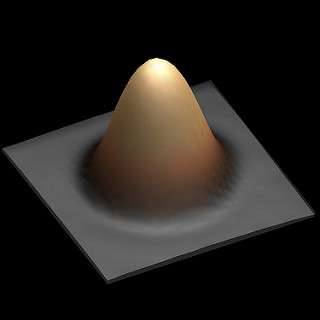Credit: IBM
An international team of researchers working at IBMs' San Jose research facility announced recently that they had created the world's smallest magnet—it was made from a single atom. In their paper published in the journal Nature, the team describes their achievement as the ultimate limit in reducing the size of magnetic storage media using the classical approach—they report that they were able to use the tiny magnet to store a single bit of data.
Ever since hard drives were invented, scientists have been hard at work trying to figure out ways to make them smaller while at the same time developing ways to make them more dense so that they can hold more information. As the team at IBM notes, currently, it takes approximately 100,000 atoms to hold a single bit of information. If a technique could be found to commercialize their single-atom approach, they further note, it would allow for holding something as massive as Apple's iTunes library of songs on something as small as a credit card.
To create their tiny magnet, the team used a scanning tunneling microscope to manipulate holmium atoms placed on a magnesium oxide plate (to keep the magnetic poles stable). Applying an electric current to the microscope's probe allowed for changing the magnetic orientation of the atom between two states, which, the team notes, could be used to represent on/off states for a single bit of data. To read the state, the team measured the magnetic current passing through the atom. The team notes also that the state of several atoms could be read or written when the atoms were as close as a single nanometer apart.
IBM has been investing heavily in scanning tunneling microscope research for decades, a technology they have been credited with inventing (Gerd Binnig and Heinrich Rohrer won the Nobel Prize in physics for this accomplishment back in 1986). Recently, they also announced that they had developed a new technique that offered a better way to measure the magnetic field of individual atoms and in a somewhat related development, also announced that they would be offering the world's first commercial "universal" quantum-computing service.
More information: Fabian D. Natterer et al. Reading and writing single-atom magnets, Nature (2017). DOI: 10.1038/nature21371
Press release by Institute for Basic Science
Journal information: Nature
© 2017 Phys.org























